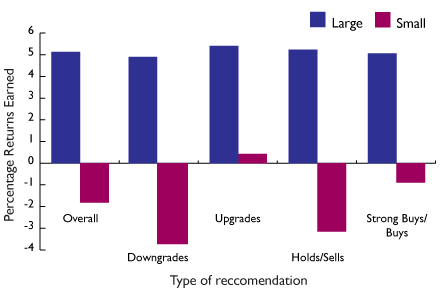Aug 1, 2010
When Security Analysts Talk, Who Really Listens?
Large and small investors find different results when following analyst recommendations
When it comes to investing, it seems like a good idea to follow experts’ recommendations. Real-world results generally support that intuition. However not all recommendations are equally profitable, and when deciding how to act, individual investors should take a second look at both the analyst reports and the circumstances under which the analysts operate.
Small investors reacting to a sell-side security analyst’s recommendations lose an average of nearly two percent on their trading activities in the five days after the recommendation is issued, according to research by Beverly Walther, a professor of Accounting and Information Management at the Kellogg School of Management. In contrast, large traders reacting to the same advice gain more than five percent in the same time period. Walther says it appears that small investors react to the mere issuance of recommendations, without looking at the underlying arguments in the report, assessing the credibility of the information, or considering analysts’ competing interests.
An analyst may have the incentive to issue a biased, overly optimistic report if he or she works at an investment banking house or a company that has done investment banking deals with the firm under review, Walther points out. Even analysts who do not have these relationships may have an incentive to be overly optimistic because they sometimes rely on firm management to try to get inside information and do not want to alienate the firm’s management.
To protect investors, in 2003 the Securities and Exchange Commission adopted Regulation AC. It requires stock analysts and others that issue a report on a security to certify that the views expressed are accurate reflections of their personal views. They must also disclose whether they were compensated for the views expressed.
Walther notes that despite the concerns expressed by regulators, “it’s not really clear that small investors—individuals—rely that much on analyst reports to begin with and, if they do react, that they are harmed.” Working with Michael B. Mikhail of Arizona State University and Richard H. Willis of Vanderbilt University, Walther evaluated how small and large investors respond to security analyst stock recommendations and how their returns compare.
The researchers categorized investors based on the amounts of their trades: “large” was defined as more than $30,000, and “small” was defined as less than $7,000. Walther explains that, in general, the size of the trade indicates the type of trader. “If they’re placing trades of $50,000 or $200,000 at a time, presumably those are fundamentally different types of entities than ones placing a trade of $1,000,” she says. “But the data available do not allow us to definitively classify the trades we see as being placed by institutions or individuals.”
Large Investors Look More Carefully at the Information
Walther and her colleagues used the Zacks Investment Research database to obtain the dates and values of recommendations issued by individual analysts during 1993 to 1999, prior to the implementation of Regulation AC. “If you look at one of these analyst reports on a firm, you’ll see there’s a lot of ‘headline’ information that the media very often pulls out,” Walther says. “The analyst will say, for example, that they are issuing a buy recommendation. They give an earnings forecast or report what they expect the price to be sometime in the future for this firm.”
But Walther cautions that “more often than not, following that headline is a discussion the analyst writes, essentially justifying the recommendation.” The analyst’s report often contains information such as “what the analyst expects the demand for the firm’s products to be, industry trends, future expenses—much more detailed information that they use to come up with that summary recommendation.”
After developing measures of how much information was in each report, the researchers found that large traders’ reactions were associated with how much information was available. “If there was a lot more information in the report, large traders traded more. If there was not as much information in the report, large traders traded less,” Walther summarizes. Small investors seemed to react to the occurrence of a recommendation rather than to the information contained in the more detailed report.
Thus, both large and small investors reacted to recommendation revisions, but their reactions differed. “While large investors trade more in response to the information conveyed by the analyst’s recommendation and earnings forecast revision, small investors trade more in response to the occurrence of a recommendation,” the researchers write in a paper based on their research.
The article also reports that small investors traded more than large investors following upgrade and buy recommendations, and they traded more following upgrade and buy recommendations than they did following downgrade and hold/sell recommendations. The researchers cite evidence that the market reaction to upgrades/buy recommendations is typically less pronounced than the reaction to downgrade/sell recommendations, and they argue that as a result, upgrade/buy recommendations are less credible than downgrade or hold/sell recommendations. It seems that small investors do not take this into consideration when reacting to analysts’ recommendations.
Large Traders Earn More than Small Traders
Surprisingly, small traders tended to be net purchasers following recommendation revisions, regardless of the direction of the recommendation revision. Conversely, large traders tended to be net sellers following downgrades and sells. As a consequence of the differences in trading patterns, small traders tend to lose money and large traders tend to make money. This finding provides some support for regulators’ concerns that analysts may easily mislead small investors, Walther and her colleagues conclude in their paper.
The researchers’ analysis shows that large traders tended to make money regardless of the type of recommendation. Conversely, small traders lost money overall, as well as after downgrades and sells. Large traders earned an average of 5.1 percent compared with a 0.9 percent loss for small traders following strong buys/buys. The difference was even larger for the trading period following hold/sell recommendations, when large traders earned 5.2 percent and small traders lost 3.1 percent.
Figure 1. Estimates of how much money was made or lost by large and small investors in the five trading days following the issuance of a recommendation.
In addition, even though small traders bought more than large traders did following upgrade and strong buy/buy recommendations, small traders made less money from these trades. Large traders earned 5.4 percent following an upgrade recommendation, compared with earnings of 0.4 percent for small traders. “This finding is surprising given that returns surrounding these recommendations are, on average, positive,” the researchers write. “One possibility is that large traders are able to discern which recommendations are associated with more profitable returns while small traders are not.”
Walther and her colleagues conclude that their research “provides preliminary evidence supporting regulators’ concerns that small investors do not properly consider the effects of analyst incentives on report credibility when reacting to recommendations.” They note that because their analyses are based on analyst recommendations issued prior to the passage of Regulation AC, it “remains an open question whether these disclosures are effective in mitigating small investors’ apparently suboptimal investment decisions.”
Mikhail, Michael B., Beverly R. Walther, and Richard H. Willis. 2007. “When security analysts talk, who listens?” The Accounting Review, 82: 1227-1253.



